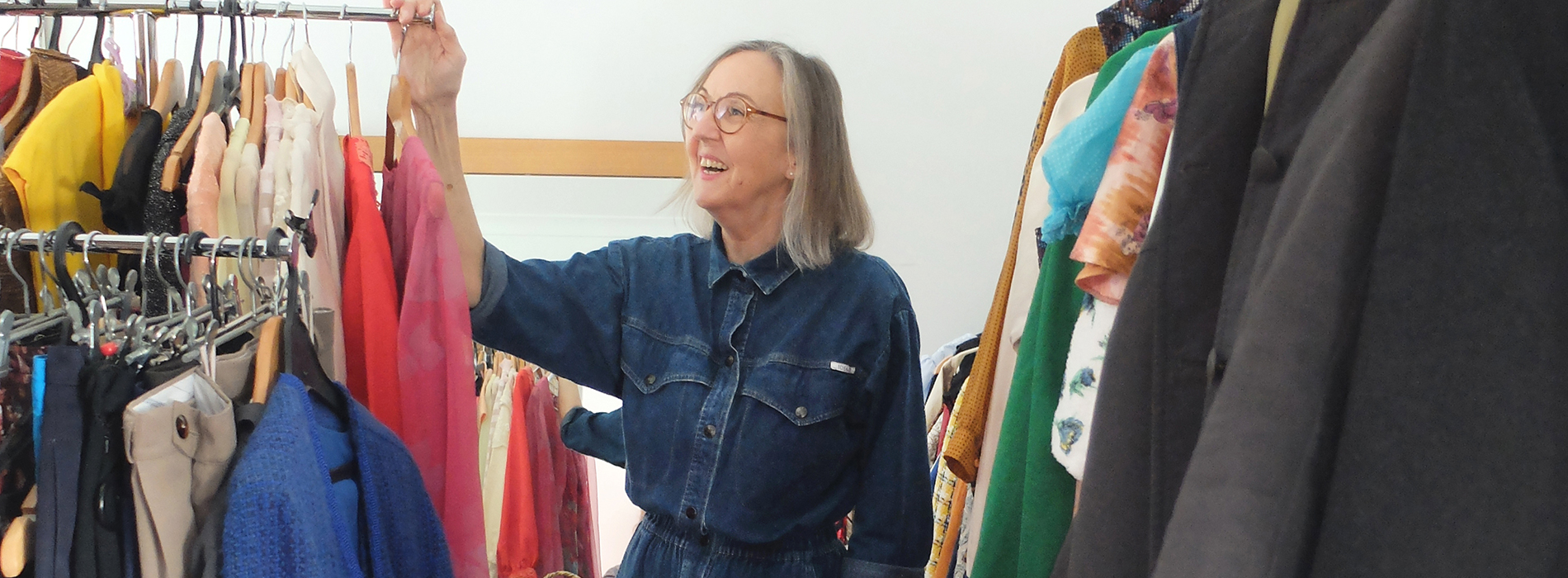
Culture Etc.

Above: Diane Ludwig in her spare room.
Photo: Imogen Greenfield
A Fashion Education
The Aucklander behind a quietly influential second-hand clothing business is part saleswoman, part detective, part fashion encyclopaedia.
By Tess Nichol
Clothes are the first thing you see when you walk into Dianne Ludwig’s house. Boxes of them frame the short hallway, waiting to be unpacked and sorted. In the living room is a rack of vintagewear: a Liberty floral housecoat, an embroidered cream cape-dress in near-perfect condition. On the deck you’ll find wooden clothes horses draped with freshly washed woollen jumpers, drying in the crisp autumn sun. The spare room lost its double bed a while ago, replaced with racks heaving with evening gowns, summer dresses, blouses, pairs of trousers, silky slips layered 10 to a hanger. Originally everything was supposed to fit into one wall of built-in storage shelves in Ludwig’s 100-square-metre home in Auckland’s Freemans Bay, but those are now stuffed to overflowing with shirts and jeans and woollens. There are more clothes still at the bach she and her husband own in Mangawhai. When asked exactly how many items of second-hand clothing she has, Ludwig’s voice drops to a mock-whisper. “I hate to think,” she says, before guessing at somewhere around 1000.
In theory, all of these clothes, discovered in op shops and Trade Me listings and estate sales, or gifted from private collections, are stock to be sold through Ludwig’s Instagram shop, Welcome Back Slow Fashion. In reality, Ludwig sees each piece as a small treasure, valuing them as much for their history as their profit potential. A pair of New Zealand made vintage Levis are a guaranteed sale. “[But] the ones that particularly make my heart beat are ones that no one else has ever heard of, that we made at the factory I worked at in Te Kauwhata. My mum was QC [quality control] at that factory and I think to myself, ‘Mum would have touched this’.”
She can spot the tell-tale sign of a classic 1970s polyknit from across the op-shop floor and rattles off obscure designer labels like they’re the names of old friends.
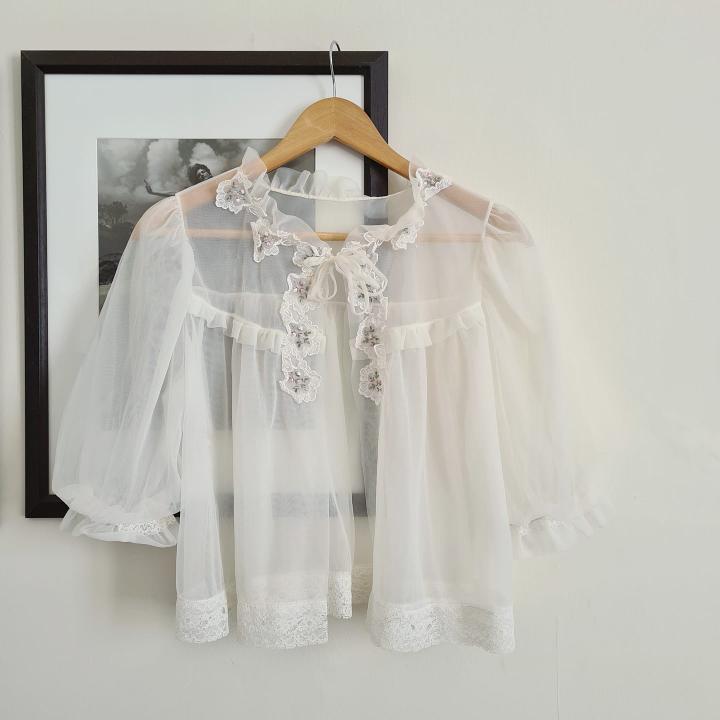
Ludwig has been selling quality second-hand and vintage clothing with a focus on New Zealand brands since 2015, starting out on Trade Me and switching to Instagram in 2018 after realising that it was increasingly where the industry was operating online. By 2020, she had a healthy number of followers. Then lockdown hit and online shopping boomed. Ludwig now has 8583 followers, which makes her a “nano-influencer” in socialmedia parlance, though the 58 year old would likely reject the label as strongly as she rejects the use of Instagram beauty filters. Slight and silver haired with a pair of round tortoiseshell glasses framing her face, Ludwig dresses most days in stylish yet practical wear like a pair of Rollas dungarees layered over a ribbed black turtleneck, or a navy jumpsuit and plimsolls. If she’s got somewhere to go she might “pull out all the stops” with a 1970s silk designer jumpsuit, but she is essentially unfussy in both presentation and manner. She has also, in recent years, come to the conclusion that capitalism is destroying the planet.
Welcome Back Slow Fashion (the name signifies Ludwig’s rejection of fast fashion and consumerism) started as a small post-retirement project born from a love of fossicking around in op shops. It now keeps Ludwig busy seven days a week. “It’s kind of like, this business that was all about sustainable things . . . ,” she cuts herself off as she contemplates just how much time she now spends on the project. “But anything I’ve done in my life in terms of careers, I’ve never done in what other people would view as a sustainable manner.”
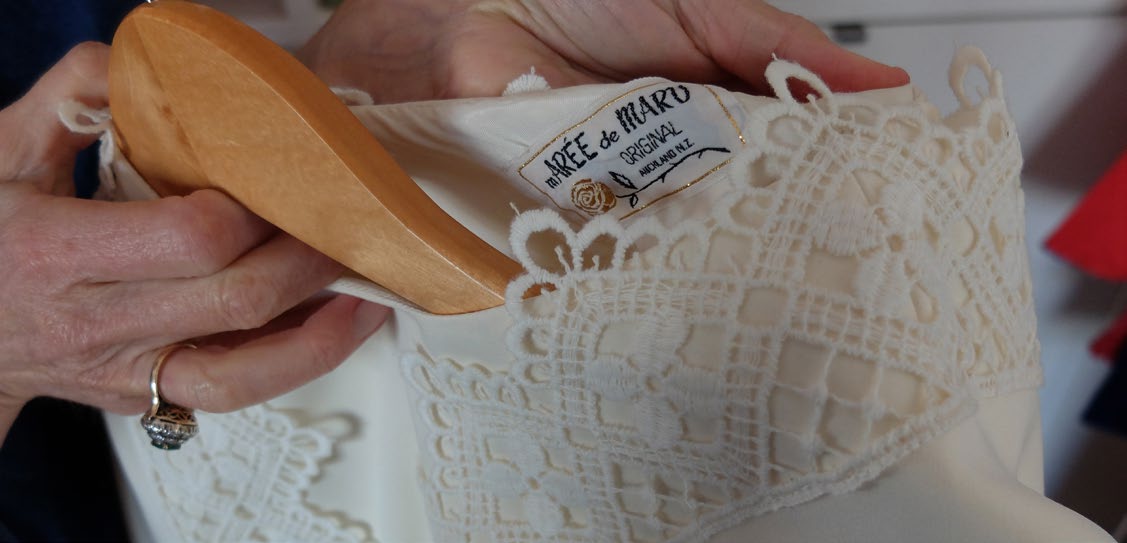
Ludwig inspects a garment’s detail.
Ludwig grew up in Rangiriri, a small town about half an hour’s drive north of Hamilton, in a family without much money, although she says she never thought about that at the time. Her mum, who dropped out of school at 13 to milk cows, could knit but never learned how to sew. “I often have followers who have these amazing stories of their grandma who had an amazing wardrobe or was a great seamstress — there was none of that in my family,” Ludwig says. After high school, she studied business management at the University of Waikato and during the holidays she worked with her mum in a cut-make-and-trim factory sewing clothes in Te Kauwhata, the kind of business once found all over New Zealand.
For most of her professional life, Ludwig worked in the corporate world, starting with a stint in London with the oil exploration company Texaco “making really good coin.” (She now describes Texaco as “evil”). She later worked as a partner in an accounting firm, running its business strategy and consulting arm. Some of her favourite clients were fashion labels. “They were hard working, most worked for very little,” she says. “They were creative and most of them didn’t come from money. They were the kind of people I felt I related to well.”
This is probably not how people assume she entered the fashion world, Ludwig says. For a while she was on the board of the New Zealand Fashion Museum — its founder, the designer Doris de Pont, was a client and she more or less invited herself along. Advising fashion labels back in the 1980s fascinated Ludwig because they involved everything: manufacturing, marketing, branding, selling. During those years, she ended up advising some to move their manufacturing operations offshore — from places like the factory where her mum had worked. “Now I think, ‘I can’t believe I advised that’,” she says. “But at the time it was what they had to do to stay competitive.”
Her current philosophy is borne of seeing the damaging effect of fast, cheap fashion since it arrived in New Zealand in the early 1990s. It’s not just the thousands of workers, mainly women, who lost their jobs when local companies moved offshore in search of cheaper labour and production costs, but the environmental impact of both the making and discarding of enormous quantities of clothing. If she’d started her Slow Fashion shop 20 years ago, Ludwig says she would have run it like a proper business, tried growing it into something big. But now the very idea of growth, in the economic sense, disgusts her. “I think it’s quite repulsive,” she says. “Selling for the sake of selling.”
“I feel like everything has completely gone off the rails,” she says. “This whole cycle of getting people to consume and on this treadmill of constantly buying, it’s ruined the planet.”
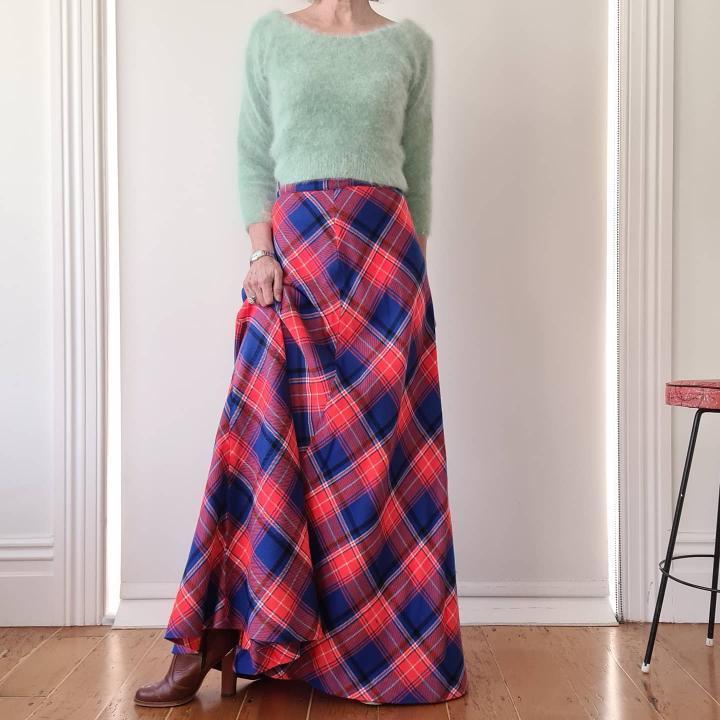
Photo from Dianne Ludwig’s Welcome Back Slow Fashion instagram account. Courtesy of Dianne Ludwig.
“I feel like everything has completely gone off the rails,” she says. “This whole cycle of getting people to consume and on this treadmill of constantly buying, it’s ruined the planet.” Clothing isn’t kept or valued like it used to be, either. “People don’t care, they’ve got a pile of shit they put in a bag and take to the op shop.” In her Instagram bio Ludwig has a simple message: “Buy less. Love each piece more.”
The actual selling of the clothes is fairly labour intensive. It requires washing and the odd mending job, as well as photographing, pricing and listing each piece on Instagram in twice-weekly “drops” of about 20 items. Ludwig styles, models and photographs the clothing herself, and no detail goes unnoticed. She’s good at spotting what she calls the “fall in love factor” in a garment, whether it’s a delicate top stitch or a strategic pop of colour. “I particularly look for New Zealand-made — though if a piece of Chanel turned up, I wouldn’t say no,” she says. “I try and buy stuff that I would wear, and because I’ve been around so long I enjoy a much broader taste in fashion than people who are just boho, or just suits or whatever.” She picks up a bright red Youth Craft cape jacket with a detachable hood hanging nearby, found recently in a Whangarei op shop. “I love the versatility,” she says. “For me, there’s a lot to fall in love with on that one.”
Zoe Walker Ahwa, co-founder of online fashion magazine Ensemble and former editor of Fashion Quarterly, says Ludwig has a “brilliant eye”. “It’s about knowing when a vintage garment is well-made, and whether it can be worn in a modern context,” she says. Seeing an older woman in an online space typically dominated by 20-somethings focusing on streetwear and throwback Y2K-era fashion is refreshing too. “Di offers a much broader range of pieces for women who have already developed their own unique sense of style.”
Most of all, she says, Ludwig’s approach works because she doesn’t get caught up “in the bullshit side of fashion”, that is, PR and marketing. “As a fashion writer, I’ve always been much more interested in the stories of clothes [and] the people who wear or make them, rather what designers and magazines say are trends,” Walker Ahwa says. She calls Ludwig’s Instagram posts “a sort of fashion education”.
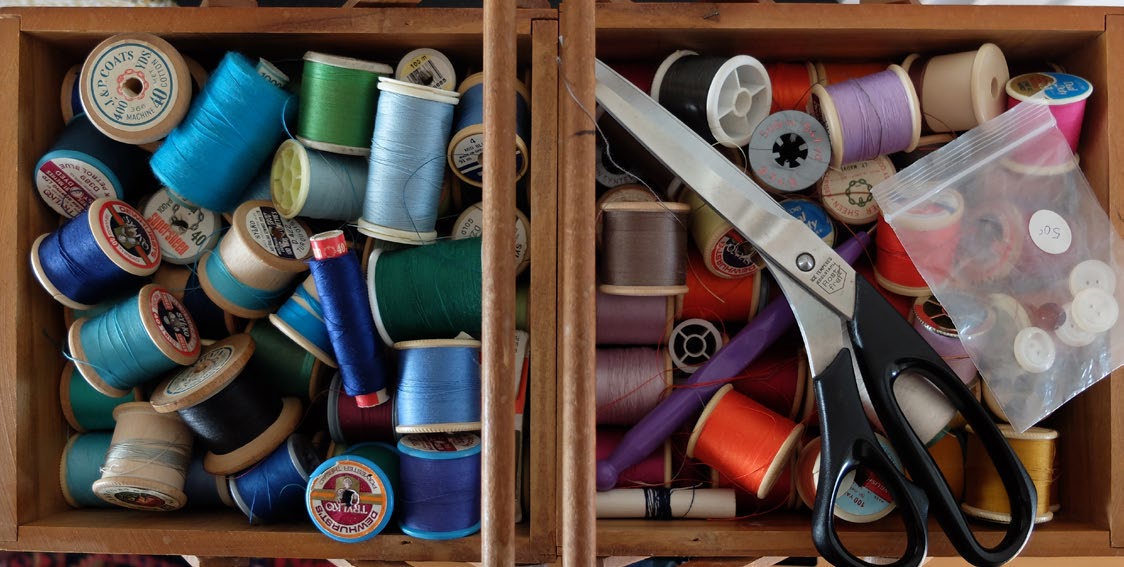
Sewing gear for mending.
Earlier this year, a woman named Irene got in touch with Ludwig and told her she wanted to own a piece of clothing made by her aunt Madeleine, a master seamstress. She didn’t know for sure which label her aunt had worked for or the name of the factory. She only had a vague memory that they made coats and that it was “somewhere on K Road”. Ludwig thought back to a listing she’d posted a while back of a 1980s Nalla wool coat. In the comments, local designer Paul Chaplin described doing his cutting apprenticeship with Nalla in a factory off Karangahape Road. Was that where Madeleine had worked, Ludwig asked Irene? It was. Even better, the coat was still available, and Irene got her wish. In another post, Ludwig asks her followers to keep an eye out for clothes designed by Jenny Haggitt, whose daughter is trying to track down some of her mum’s old pieces. “Hope we can get this vintage back in the family wardrobe,” she wrote, followed by two green heart emojis.
There are hordes of vintage sellers operating on Instagram these days, but few have Ludwig’s breadth of knowledge. She can spot the tell-tale sign of a classic 1970s polyknit from across the op-shop floor and rattles off designer labels like they’re the names of old friends: Flair Girl, Betty Barclay, Diana Knight, Rosaria Hall, Flookies, Esprit, Fashionbilt, Youth Craft, Klipper, Zambesi. “I love finding the pieces that are, in terms of resale, prestigious: the El Jays and the Thornton Halls and the Hullabaloos,” she says. “I also, to be honest, love finding the little smaller labels too, like Fidgits.”
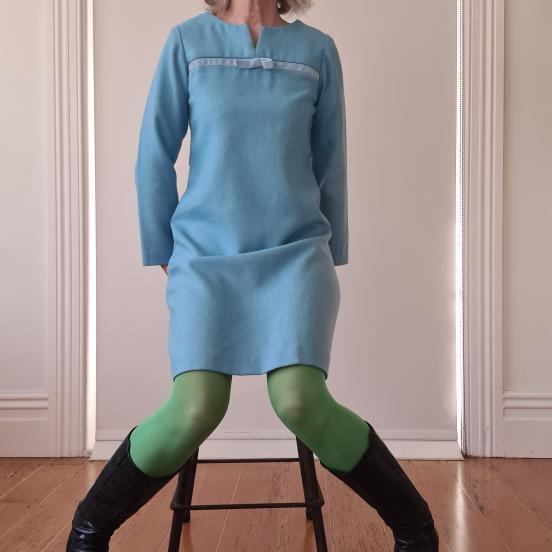
Photo from Dianne Ludwig’s Welcome Back Slow Fashion instagram account. Courtesy of Dianne Ludwig.
If you DM her on Instagram, a response is never too far away. Ask her about one brand, and she’ll tell you the name of their parent company and what became of them (one big label just makes souvenir tea towels these days), or which designer got their start in whose factory, illustrating her point by producing a piece of their clothing from her vast collection. This is how the industry used to be — tightly interwoven, like silk. Once, the New Zealand fashion landscape was made up of mid-size companies with more of a connection to their communities, Ludwig says. Now it’s mostly large players looking for “where they can get the lowest possible make price and still somehow stamp it as ethical”.
Ludwig isn’t so much a saleswoman, but a clothing detective, a historian, and a fashion philosopher. “That’s why it’s become seven days a week — answering people’s questions, talking to people online,” she says. “They’ll show me something their grandmother had or say, ‘hey have you heard of this label’, and often I’ll do research and stuff for people, which I probably shouldn’t do. I get sucked into this rabbit hole. But then I think that’s part of it too, I want to get people back interested in [the story of clothes].”
She reckons if she stopped doing the rest she could more than double the number of items she sells each week. But the rest is what makes the entire project worthwhile: people reconnecting with clothes in a way which is about longevity, rather than cycling through ever-faster fashion trends.
Each listing on her store comes with a detailed caption describing the piece’s particular characteristics and era-specific flourishes, written in a friendly but authoritative tone. “I try to give some kind of, not education, but do some storytelling of who was behind the label and how it got started and some of that quirky stuff,” she says. Of a vintage leather jacket by Christchurch designer Caroline Moore, which she has pinned as late 1980s or early 90s, Ludwig writes that Moore would have been working exclusively with lambskin. This is “the softest of leather” and will have been sourced locally at a Timaru tannery, she explains. “[The] leather is buttery soft, pleating at front, slight dolmain sleeve, front pockets, lots of detailing. Fully lined, great condition. A classic shape which won’t date.”
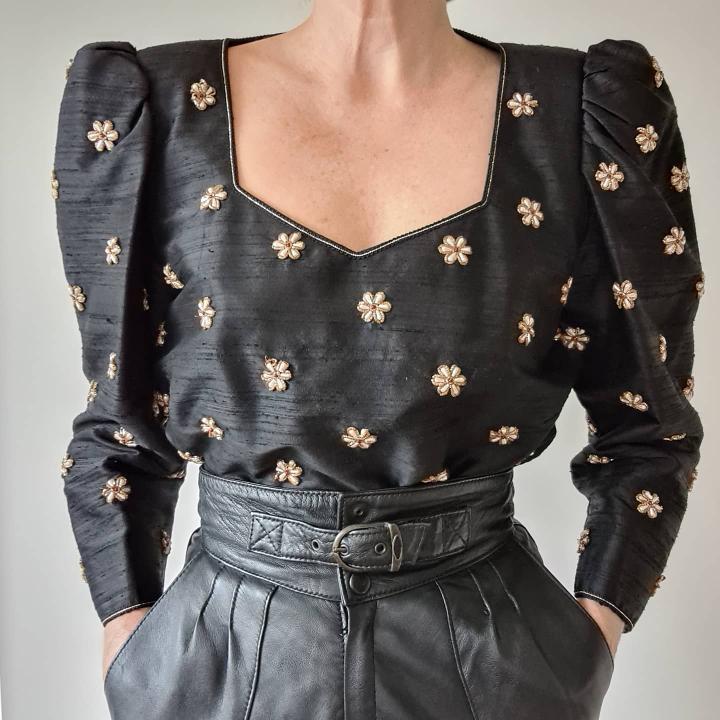
Photo from Dianne Ludwig’s Welcome Back Slow Fashion instagram account. Courtesy of Dianne Ludwig.
Similar attention goes into the pricing. Ludwig tries to make sure her pieces aren’t so expensive that they exclude shoppers on a budget, but aren’t so cheap that people will just buy them without proper consideration. She wants each piece to be loved, treasured and ultimately, worn. This is also why she refuses to dump unsold items in op shops, which by necessity send stock they can’t move to landfill. Some of the hardest pieces to sell, Ludwig says, are among the most beautiful; bespoke gowns and formal evening wear from designers like Colin Cole and Patrick Steel. Most people just don’t lead the kinds of lives where they’ll get much wear out of them, Ludwig says. But since the thought of such garments going to landfill is unbearable, she keeps them in the hope she can sell them later. Years later, if that’s what it takes — fashion is cyclical, after all.
Ludwig manages to walk a fine line: she’s concerned, sometimes even righteously angry, but never sanctimonious. She’s knows that for many people, buying local or ethically made clothing isn’t a high priority because they’re too busy trying to afford the rent or feed their kids. It’s the industry which needs to rethink its priorities, she says, though she’s not too hopeful that will happen.
Will she ever sell it all? Empty the boxes, clear the racks, air out the cupboards? “I don’t know,” she says. “Do I care? No.” As long as she’s still finding joy in the stories of clothes, she could see herself doing this until she’s 80.
Tess Nichol is North and South’s deputy editor. She spends most of the money she should be saving for a house deposit on clothing.
This story appeared in the August 2021 issue of North & South.


